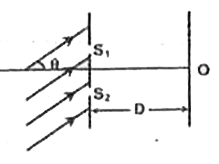In Young's double slit experiment if monochromatic light is replaced by white light
All bright fringes become white
All bright fringes have colours between violet and red
Only the central fringe is white, all other fringes are coloured.
No fringes are observed.
The correct Answer is:C
To solve the question regarding the effect of replacing monochromatic light with white light in Young's double slit experiment, we can follow these steps:
1. Understanding White Light:
- White light is composed of multiple wavelengths (colors) ranging from violet to red. Each color corresponds to a different wavelength.
Hint: Recall that white light is a mixture of all colors of light.
2. Interference Pattern with Monochromatic Light:
- In Young's double slit experiment, monochromatic light produces a clear and distinct interference pattern with alternating bright and dark fringes due to constructive and destructive interference.
Hint: Think about how monochromatic light creates a uniform pattern with consistent spacing.
3. Replacing Monochromatic Light with White Light:
- When white light is used, each wavelength will produce its own interference pattern. However, these patterns will overlap on the same screen.
Hint: Consider how different wavelengths will interfere at different positions on the screen.
4. Central Fringe Analysis:
- The central fringe (where there is no path difference) will receive light from all wavelengths simultaneously, resulting in constructive interference. Thus, the central fringe will appear white.
Hint: Remember that the central fringe is where all colors combine constructively.
5. Fringes on Either Side:
- As you move away from the center, different wavelengths will constructively interfere at different positions due to their varying path differences. This will lead to the formation of colored fringes on either side of the central white fringe.
Hint: Visualize how colors spread out as you move away from the center due to different wavelengths.
6. Conclusion:
- Therefore, the correct conclusion is that only the central fringe will be white, while all other fringes will display colors ranging from violet to red.
Hint: Focus on the fact that the separation of colors occurs due to the different wavelengths interfering at different positions.
Final Answer:
The correct option is: Only the central fringe is white; all the other fringes are colored. (Option 3)
- White light is composed of multiple wavelengths (colors) ranging from violet to red. Each color corresponds to a different wavelength.
- In Young's double slit experiment, monochromatic light produces a clear and distinct interference pattern with alternating bright and dark fringes due to constructive and destructive interference.
- When white light is used, each wavelength will produce its own interference pattern. However, these patterns will overlap on the same screen.
- The central fringe (where there is no path difference) will receive light from all wavelengths simultaneously, resulting in constructive interference. Thus, the central fringe will appear white.
- As you move away from the center, different wavelengths will constructively interfere at different positions due to their varying path differences. This will lead to the formation of colored fringes on either side of the central white fringe.
- Therefore, the correct conclusion is that only the central fringe will be white, while all other fringes will display colors ranging from violet to red.
The correct option is: Only the central fringe is white; all the other fringes are colored. (Option 3)
Similar Questions
In Young's doble-slit experiment, if the monochromatic source of light is replaced by white light, then one sees
View SolutionIn Young's double-slit experiment, if yellow light is replaced by blue light, the interference fringes become
View SolutionIn Young's double slit experiment parallel monochromatic light is incident on both the slits at an angle as shown in the figure. To obtain the central maxima at on the screen we can

View Solution(a) Why are coherent sources necessary to produce a sustained interference pattern ?
(b) In Young's double slit experiment using monochromatic light of wavelength λ, the intensity of light at a point on the screen where path difference is λ, is K units. Find out the intensity of light at a point where path difference is λ/3.
View SolutionIn the Young's double slit experiment using a monochromatic light of wavelength λ, the path difference (in terms of an integer n) corresponding to any point having half the peak
View SolutionIn the Young's double slit experiment using a monochromatic light of wavelength λ, the path difference (in terms of an integer n) corresponding to any point having half the peak
View SolutionIn Young's double-slit experiment using monochromatic light of wavelength λ, the intensity of light at a point on the screen where path difference is λ, is K units. What is the intensity of lgight at a point where path difference is λ3.
View SolutionIn Young's double -slit experiment, why do we use mono chromatic light ? If while light is used, how would the pattern change ?
View SolutionIn Young.s double slit experiment sodium light is replaced by blue lamp, then the fringe width
View SolutionFind the angular fringe width in Young's double slit experiment using a monochromatic light of wavelength 500 nm when the slits are separated by 2.5 mm.
View Solution